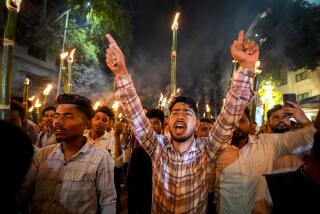Worries Multiply Along With India’s Population
- Share via
NEW DELHI — When Asha, a frail Delhi slum dweller, had her sixth daughter two years ago, doctors advised her to be sterilized immediately.
But the 35-year-old domestic servant would not hear of it. In a country where, as the saying goes, women are blessed to be mothers of a hundred sons, Asha believed it would be sacrilegious for her not to have a son. “We needed a son to carry on the family name,” said the migrant from the country’s most populous state, Uttar Pradesh, after she finally gave birth to a son this year.
Asha is one of millions of women across the country who have pushed India’s population to 1 billion, a milestone that--officially at least--will be reached today amid an odd mix of celebration and introspection.
“The billion figure is symbolic because it will help us sit up, take stock of things and think of what we have to do,” said Population Foundation executive director K. Srinivasan.
India was among the first countries to launch a state-sponsored family planning program, in 1952, to try to curb its rapidly growing population when it was around 360 million. The population has almost tripled since then.
According to Planning Commission projections, if India continues at its current rate of adding 15.5 million people a year, it could overtake China to become the world’s most populous country by 2045.
India’s population growth rate, although down from its peak of 2.22% between 1971 and 1981, is still 1.91%, more than double that of its giant neighbor to the north.
“While the global population has increased threefold during this (20th) century, from 2 billion to 6 billion, the population of India has increased nearly five times from 238 million to 1 billion,” a recent government report said.
So what went wrong?
Demographers say India failed to rein in its population growth due to a disastrous experiment with forced sterilization in the 1970s when then Prime Minister Indira Gandhi suspended civil rights.
“Forced sterilizations did permanent damage to the family planning policy. As a result, family planning became a dirty word in India,” leading demographer Ashish Bose said.
Meenakshi Datta Ghosh, joint secretary in the ministry of family welfare, agrees: “Our experience with compulsion in the 1970s has been unhappy. It led to deep-seated anger and deferred the family planning program by about two decades.”
Experts say the policy also failed because it was too target-oriented and because sharp declines in death rates were not accompanied by a similar drop in birth rates.
“The basic formula was that family planning equals to sterilization, which equals to female sterilization, which equals to target fulfilling. Since this is difficult, it led to cooking of data,” Bose said.
This year, the government announced a new population policy not bound by numerical targets but offering incentives for two-children families and for delaying marriage.
The new policy, which follows an earlier shift in emphasis from demographic control to health care and education of women, aims to bring fertility rates down to replacement levels by 2010 and achieve what it calls a stable population by 2045.
“In patriarchal societies men continue to determine reproductive choices. Here the focus is on the role and responsibility of men,” Ghosh said.
But population experts slammed the policy, saying it did not address what are called the chronically backward “Bimaru” states of Bihar, Madhya Pradesh, Rajasthan and Uttar Pradesh, which account for 40% of India’s population.
“It is ridiculous for bureaucrats to put targets on the reproductive lives of people. What we need is a minimum needs program which includes roads, water, health and education,” Bose said.
Aid agencies warn that the alarming growth levels are putting intense stress on the country’s already creaking infrastructure and stretching food and water resources.
The government has difficulties enough with its current population. About half of India’s adults are illiterate, a third live below the poverty line and more than 15% of children younger than 15 suffer from malnutrition.
Although India has cut its fertility rate to 3.3 children per woman from six in 1951, and the birth rate has declined to 26.4 from 40.8 per 1,000, aid agencies are not impressed.
“The future is not as bright as was the past,” the U. N. Population Fund warned in a recent report, saying population growth “can lead to hunger, even starvation, unless careful planning regulates both demand and supply levels to create the necessary balance.”
More to Read
Sign up for Essential California
The most important California stories and recommendations in your inbox every morning.
You may occasionally receive promotional content from the Los Angeles Times.













